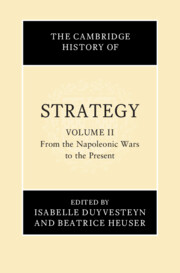Book contents
- The Cambridge History of Strategy
- The Cambridge History of Strategy
- The Cambridge History of Strategy
- Copyright page
- Dedication
- Contents
- Maps
- Contributors to Volume II
- Preface and Acknowledgements
- Introduction to Volume II
- 1 The Strategies of the Napoleonic Wars
- 2 Guerrilla and Nineteenth-Century Strategies of Insurgency
- 3 Russia, 1877–1917
- 4 The American Civil War
- 5 The Use of Naval Power
- 6 The Russo-Japanese War
- 7 Chinese Strategy, 1926–1949
- 8 First World War
- 9 Soviet Strategy, 1917–1945
- 10 Air Power
- 11 The Second World War in Europe
- 12 The Second World War in the Asia–Pacific
- 13 Soviet Strategy, 1945–1989
- 14 People’s War and Wars of Decolonisation
- 15 Nuclear Strategies
- 16 America’s Way of War
- 17 The Korean War
- 18 Israel’s Wars
- 19 The India–Pakistan Confrontations
- 20 The Yugoslav War, 1991–1999
- 21 Terrorism and Insurgency
- 22 The Forty-Year War in Afghanistan
- 23 The Three Gulf Wars and Iraq
- 24 China’s Wars, 1950–2021
- Conclusion
- Further Reading
- Index
Introduction to Volume II
The Practice of Strategy
Published online by Cambridge University Press: 06 January 2025
- The Cambridge History of Strategy
- The Cambridge History of Strategy
- The Cambridge History of Strategy
- Copyright page
- Dedication
- Contents
- Maps
- Contributors to Volume II
- Preface and Acknowledgements
- Introduction to Volume II
- 1 The Strategies of the Napoleonic Wars
- 2 Guerrilla and Nineteenth-Century Strategies of Insurgency
- 3 Russia, 1877–1917
- 4 The American Civil War
- 5 The Use of Naval Power
- 6 The Russo-Japanese War
- 7 Chinese Strategy, 1926–1949
- 8 First World War
- 9 Soviet Strategy, 1917–1945
- 10 Air Power
- 11 The Second World War in Europe
- 12 The Second World War in the Asia–Pacific
- 13 Soviet Strategy, 1945–1989
- 14 People’s War and Wars of Decolonisation
- 15 Nuclear Strategies
- 16 America’s Way of War
- 17 The Korean War
- 18 Israel’s Wars
- 19 The India–Pakistan Confrontations
- 20 The Yugoslav War, 1991–1999
- 21 Terrorism and Insurgency
- 22 The Forty-Year War in Afghanistan
- 23 The Three Gulf Wars and Iraq
- 24 China’s Wars, 1950–2021
- Conclusion
- Further Reading
- Index
Summary
In this first global history of strategic practice, we define strategy making (following K. Kagan) as making choices, prioritising means in pursuit of political ends in the context of armed conflict, actual or threatened. The usage of the term took a long time to spread from the East Roman Empire to the Occident, and most civilisations discussed in these volumes did not have a distinct word to describe what they were doing in the modern sense. Yet by applying Kagan’s definition, we see evidence of complex reasoning and prioritisation of means and ways; even the greatest empires could not pursue unlimited ends. Our volumes bring together experts on each individual civilisation and period to explore analogous dimensions of strategy making: who are the enemies, and why? What means are available to them? What are the political strategic goals? And the central questions: how were ultimate and immediate goals formulated, and how were they linked up with military means? What were the enablers and limitations, in terms of geography, resources and other means, which produced distinctive approaches? But also, was there a transfer of ideas and methods? How were they translated, adopted, enacted, imitated and emulated in warfare around the world?
- Type
- Chapter
- Information
- The Cambridge History of Strategy , pp. 1 - 17Publisher: Cambridge University PressPrint publication year: 2025

